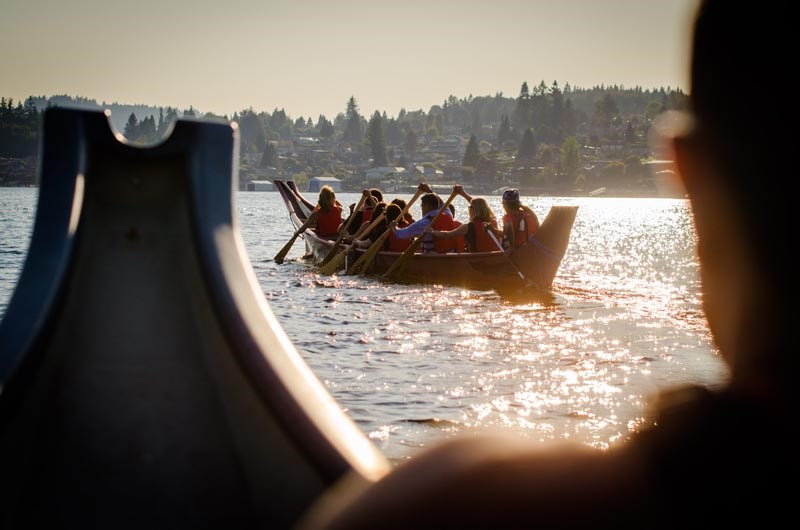“It is quite an interesting experience, I would say,” said Healy, who is also a wilderness guide with the Səlilwətaɬ (Tsleil-Waututh) seasonal cultural tour company.
“I think a lot of people have been in kayaks or canoes or on paddle boards, but when you’re in a big ocean-going canoe, there’s quite a bit of power, and you really feel a special connection to everybody else that’s in the canoe, as well as the canoe and the water itself.”
After a lengthy hiatus, Takaya Tours has put its big canoes back on the water, offering people the opportunity to experience the culture, tradition, and history of the Səlilwətaɬ people in a hands-on way.
Paddles were back in the ocean earlier this month after COVID-19 pandemic restrictions eased up, said Healy.
Like many other businesses, Takaya Tours shut down during the lockdown which was enforced in British Columbia in March 2020 – initially losing $100,000 in cultural tour bookings, said Whonoak (Dennis Thomas), Takaya Tours’ business development manager, in an interview earlier this year.
Takaya Tours later reopened in June, with physical distancing in place, but closed the entire cultural canoe side of the business for the year to avoid confusion from people who may have seen the 20-seater canoes out on the water and thought the company was breaking social distancing rules.
“We didn’t want to face public shaming or have to deal with that sort of damage control,” Thomas explained.
Instead, they focused all their efforts on promoting kayaking, which could be easily physically distanced in one-seater or two-seater kayaks and were able to survive the entire season based on their rentals and a few different grants from Indigenous Tourism BC and the Indigenous Tourism Association of Canada.
Thomas said the company saw an increase of more than 50 per cent in kayak bookings across its two paddling centre locations at Whey-ah-Wichen (Cates Park) and Belcarra Regional Park last summer, putting it down to more people wanting to get outdoors after the lockdown to enjoy nature.
Now, Healy said cultural tour bookings were already beginning to pick up, with two of the four canoes out on the water last week and bigger tours planned for fall with a lot of school groups.
He said there had been a lot of interest after the recent news of the discoveries of unmarked graves at residential schools in B.C., which had raised awareness of First Nations, and people were wanting to learn more about the Səlilwətaɬ culture.
For the past 10 years, Healy has worked with the replica ocean-going canoes, which are similar to those used by the Səlilwətaɬ historically.
On the tours, he said guests get to paddle in the protected waters of the Burrard Inlet and Indian Arm while Coast Salish guides sing songs, tell legends and point out ancient village sites including Whey-ah-Wichen and the winter village site, təmtəmíxʷtən (Tum-tumay-whueton), in Belcarra Regional Park.
“Our canoe tours are about showing the traditional territory of the Səlilwətaɬ people,” he said.
“You learn about the history of Coast Salish people, as well as hear some of the legends and stories that are important to the Səlilwətaɬ. It’s about understanding where people are; you know, we’re on Indigenous lands. And it’s hard to get that outlet to see firsthand what’s been here for thousands of years.”
He said Takaya also worked with a lot of other First Nations groups.
“It gives the First Nations community an outlet to some culture as well,” Healy said. “There’s a slot of people whose ancestors paddled these waters but they themselves haven’t necessarily had the opportunity.”
The canoe tours are typically two hours, but occasionally Takaya takes special requests for longer tours or overnight adventures.
Healy said they were currently taking groups of 10 instead of 20, with a minimum of 10 people needed to move the 35-foot canoes.
“We don’t operate with motors,” he said. “It’s nice to have detachment from motorized vehicles.”
“Everyone has a paddle in their hand and if we don’t paddle, we don’t move very fast or far. It’s always nice when we get a good strong group, we get further, and we get to show them more.”
Healy said he was looking forward to having a busy summer and getting all the canoes out on the water at once. “It’s always great when we have multiple canoes out, it feels like a real canoe journey,” he said.
Elisia Seeber is the North Shore News’ Indigenous and civic affairs reporter. This reporting beat is made possible by the Local Journalism Initiative.



